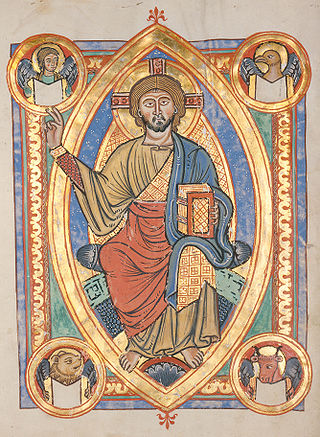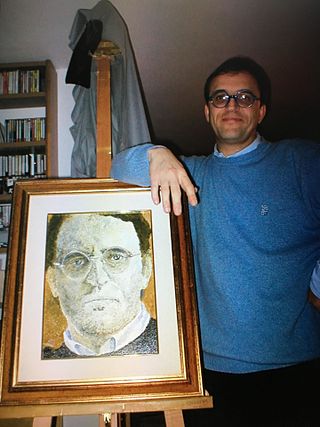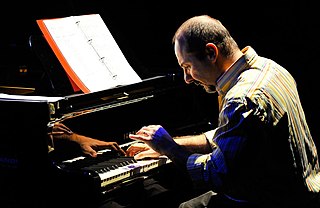
Stefano Vagnini (born 1963) is an Italian musician, composer, researcher, poet and Modular Art theorist.

Stefano Vagnini (born 1963) is an Italian musician, composer, researcher, poet and Modular Art theorist.
Stefano Vagnini was born in Fano, Italy.
Vagnini studied organ, composition and electronic music at the “G. Rossini” conservatory in Italy and at the Georgia State University in Atlanta, USA. He graduated in organ, organ composition with Professor Armando Pierucci and in electronic music with Professor Eugenio Giordani from the Conservatorio Statale di Musica in Pesaro (Italy). He attended several prestigious Organ masterclasses with famous organists such as Monserrat Torrent, Michael Radulescu, Liuwe Tamminga, André Isoir, Sarah L. Martin.
Vagnini has taught organ and composition at the Conservatories in Verona and L'Aquila (Italy).
From 1986 to 2013 he has been Art Director of the International Organ Festival at Santa Maria Nuova in Fano, Italy, where internationally acclaimed organists performed, including Liuwe Tamminga, Michael Radulescu, Arturo Sacchetti, Gaston Litaize and Odile Pierre.
In 1997 he starts developing a new composing methodology, specifically applied to music, called ModulArt, which is today his main field of research.
Since 2003, together with soprano Giorgia Ragni, he forms a musical duo in art and in life called Aidaduo. Aidaduo researches, elaborates and creates new kind of concerts and Modular performances which are presented through seminars and conferences in Universities and cultural centers around the world.
Concerts as organist and choir director in Italy, [1] U.S.A (’86,’08,’09,’10,’11,’12), Germany (’92,’93,’99,’06, ’12), Austria (’99), Switzerland (’99,’10), Russia (‘95), Brazil (’95,’98), Argentina (’95,’98), Uruguay (’95,’98), China (’98,’16,’17,’18), Spain (’05,’07) England (’11), Scotland (’12), Denmark (’12), Poland (’12,’14), Finland (’12), Holland (’12), South Korea (’13,’14,’15,’16,’17), Japan (’16,’17,’18), France (’89,’06,’12,’19 ).
Vagnini has conducted the Slave Song gospel choir [2] and the Mezio Agostini opera choir in Fano, Italy.
Ballet
Theater
Video
Organ solo
Organ and tape
Orchestra
AiDADUO Style is a combination of classical music (piano and soprano) incorporating literature, cinema and fine arts mixed with a constant innovative, experimental and ironic research.
AiDADUO Performance-shows
Piano solo
ModulArt in a new composing methodology theorized and applied to music by Vagnini. [6] The modular composition system extends its procedure to compositions licensed by the musician as completed works of art. To these compositions, new modules can be overlapped. The new modules can be added by the same author in a different moment or by different authors. Greek History University Professor Umberto Bultrighini describes "Vagnini's ability to satisfy old needs and combine them with modern technology. ModulArt as the key answer to the need of defining the artist's work, finding the right balance between art, audience and copyrights". [7] Vagnini's ModulArt is theorized and applied in a theoretical book, [8] in a book + DVD of modular poems [9] and a cd. [10] Writer, painter, and art theorist Gian Ruggero Manzoni described the modularity of Vagnini's compositions as “circular like the existence, his works are not finished, but merely stimulus for new voices”. [11]
Vagnini's ModulArt in musical composition coincides and was developed independently during the same period of time with Leda Luss Luyken's ModulArt in the realm of painting.
ModulArt Projects
ModulArt Performances
{{cite web}}: CS1 maint: archived copy as title (link)
Terrence Mitchell "Terry" Riley is an American composer and performing musician best known as a pioneer of the minimalist school of composition. Influenced by jazz and Indian classical music, his music became notable for its innovative use of repetition, tape music techniques, and delay systems. His best known works are the 1964 composition In C and the 1969 LP A Rainbow in Curved Air, both considered landmarks of minimalism and important influences on experimental music, rock, and contemporary electronic music.

The Toccata and Fugue in D minor, BWV 565, is a piece of organ music written, according to its oldest extant sources, by Johann Sebastian Bach (1685–1750). The piece opens with a toccata section, followed by a fugue that ends in a coda. Scholars differ as to when it was composed. It could have been as early as c. 1704. Alternatively, a date as late as the 1750s has been suggested. To a large extent, the piece conforms to the characteristics deemed typical of the north German organ school of the Baroque era with divergent stylistic influences, such as south German characteristics.

The Stations of the Cross or the Way of the Cross, also known as the Way of Sorrows or the Via Crucis, refers to a series of images depicting Jesus Christ on the day of his crucifixion and accompanying prayers. The stations grew out of imitations of the Via Dolorosa in Jerusalem, which is a traditional processional route symbolising the actual path Jesus walked to Mount Calvary. The objective of the stations is to help the Christian faithful to make a spiritual pilgrimage through contemplation of the Passion of Christ. It has become one of the most popular devotions and the stations can be found in many Western Christian churches, including those in the Roman Catholic, Lutheran, Anglican, and Methodist traditions.
Broadly speaking, modularity is the degree to which a system's components may be separated and recombined, often with the benefit of flexibility and variety in use. The concept of modularity is used primarily to reduce complexity by breaking a system into varying degrees of interdependence and independence across and "hide the complexity of each part behind an abstraction and interface". However, the concept of modularity can be extended to multiple disciplines, each with their own nuances. Despite these nuances, consistent themes concerning modular systems can be identified.
Christian Wilhelm Berger is a Romanian composer, organist, and a lecturer at the Bucharest Academy.

Giorgia Todrani, best known as Giorgia is an Italian singer, songwriter, musician, record producer, and radio host.

Carlo Pedini is an Italian classical composer.

Johann Sebastian Bach was a German composer and musician of the late Baroque period. He is known for his orchestral music such as the Brandenburg Concertos; instrumental compositions such as the Cello Suites; keyboard works such as the Goldberg Variations and The Well-Tempered Clavier; organ works such as the Schubler Chorales and the Toccata and Fugue in D minor; and vocal music such as the St Matthew Passion and the Mass in B minor. Since the 19th-century Bach revival he has been generally regarded as one of the greatest composers in the history of Western music.
Marian Sawa was a Polish composer, organist, improviser, musicologist, and pedagogue.

Paweł Łukaszewski is a Polish composer of choral music. He has won seven prestigious Fryderyk Awards. According to David Wordsworth, Łukaszewski is the best-known Polish composer of his generation in and out of Poland "by far".
Felix Hell is a German organist.

Yoonjung "Yoonie" Han is a South Korean-born American classical pianist.
Modular art is art created by joining together standardized units (modules) to form larger, more complex compositions. In some works the units can be subsequently moved, removed and added to – that is, modulated – to create a new work of art, different from the original or ensuing configurations.

Stefano Mainetti is an Italian composer and conductor.
Luc Ponet is a Belgian organist, academic and board member of Nationaal Instituut voor de Orgelkunst.
Musical instruments used in Baroque music were partly used already before, partly are still in use today, but with no technology. The movement to perform music in a historically informed way, trying to recreate the sound of the period, led to the use of historic instruments of the period and to the reconstruction of instruments.
Modular music is music that originates from the combination and overlapping of different compositions one over the other. The compositions —also called modules— are written by one or many different composers in different moments. New modules can be added or removed to create a totally new work, a new composition, different from the original one. A modular composition can be expanded and extended in time, space and size.

Umberto Petrin is an Italian jazz pianist, composer and poet. He devoted himself to the study of the piano at the age of 12. After studying Chemistry, he graduated in Piano at the Giuseppe Verdi Conservatory in Milan, where he is now Professor of Jazz Piano. From the age of 18 he took an active interest in contemporary poetry and began a long collaboration with literary magazines, winning several prizes and being a finalist in numerous poetry competitions.
The Sanremo Music Festival 2017 was the 67th annual Sanremo Music Festival, a television song contest held at the Teatro Ariston in Sanremo, Liguria, Italy between 7 and 11 February 2017, organised and broadcast by RAI.
Arshia Samsaminia is an Iranian composer.